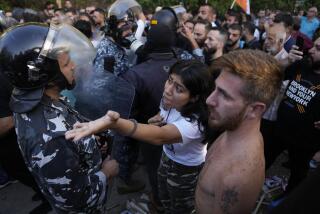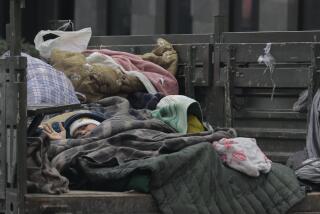Calm Returns to Armenia After Gorbachev’s Appeal
- Share via
MOSCOW — Relative calm returned to the Armenian capital of Yerevan on Saturday after an appeal by Soviet leader Mikhail S. Gorbachev to halt demonstrations backing the return of an Armenian-majority region in the adjacent republic of Azerbaijan.
Factories in Yerevan were operating and street crowds, which swelled to hundreds of thousands of people during the week, were said to be smaller, Soviet television reported.
But massive protests were said to be continuing in Stepanakert, capital of the disputed Nagorno-Karabakh region, despite Gorbachev’s appeal for a return to normal life.
There were unconfirmed reports that leaders of the demonstrations have agreed to suspend public protests for one month to see what the Kremlin does about their request for return of the territory.
Religious Support
Catholicos Vasken I, leader of the Armenian Christian Church, supported such a cooling-off period in an address on television in Yerevan. However, the clerical leader also backed the demand for transfer of the Nagorno-Karabakh region to Armenian control.
In return for halting the demonstrations, Armenians would hope to win a favorable decision from the Communist Party’s Central Committee when it takes up nationality issues at a plenum next month.
Alexander Ogorodnikov, a Moscow dissident in touch by telephone with demonstration organizers in Yerevan, told Western correspondents that a delegation led by an Armenian poet, Silva Kaputikyan, met with Gorbachev on Friday to discuss the situation.
There was no immediate confirmation of the report.
Soviet television, however, reported from Yerevan that all factories were working, even on Saturday, because workers wanted to make up for time off from work to take part in street marches.
In another development, an Armenian newspaper quoted Vladimir I. Dolgikh, a top-level Kremlin trouble-shooter in the dispute, as saying that clashes between Armenians and Azerbaijanis already have produced “victims.”
The republic’s party newspaper Kommunist, whose Wednesday edition arrived in Moscow on Saturday, gave no indication of how many were killed or injured in the outbreak of violence shortly after demonstrations started Feb. 20.
Soviet officials recently have denied there were any deaths growing out of the unprecedented public protest over who governs the mountainous region that was taken from Armenia and placed in Azerbaijan in 1923.
Problem for Gorbachev
The size of the demonstrations and the intensity of public expressions on the dispute posed a major problem for Gorbachev, now struggling to revamp the economy.
One casualty of the Armenian protests has been Gorbachev’s declaration of glasnost, or openness, on public issues.
Soviet newspaper and television reports have been skimpy or non-existent, and foreign correspondents were prohibited from traveling to Yerevan. Even the text of Gorbachev’s speech was not carried by the official Tass news agency, although leading newspapers ran summaries of what he said.
Eyewitnesses said the demonstrators carried pictures of Gorbachev to stress that their protest was not against the Soviet state.
Nevertheless, the Kremlin chief said in an address read over Armenian and Azerbaijani television that taking to the streets was deeply disturbing to the party leadership and could have “serious consequences.”
More to Read
Sign up for Essential California
The most important California stories and recommendations in your inbox every morning.
You may occasionally receive promotional content from the Los Angeles Times.










